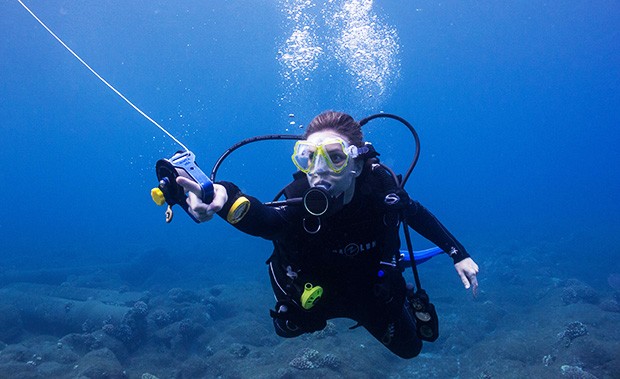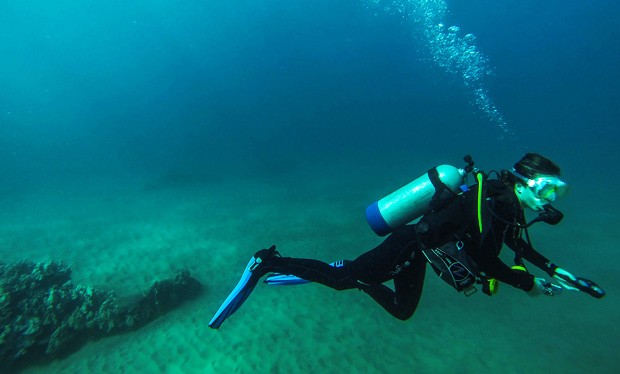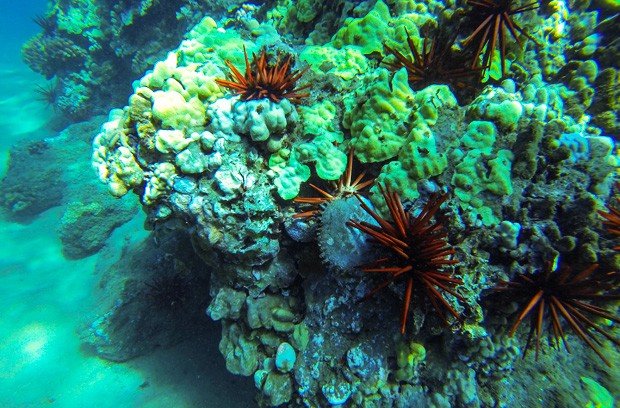Choose your own Indiana-Jones-style adventure with National Geographic
 Mikayla Wujec scuba dives off the island of Molokaʻi, Kalaupapa National Historical Park, Hawaii. | Photo by Andrea J. Reid
Mikayla Wujec scuba dives off the island of Molokaʻi, Kalaupapa National Historical Park, Hawaii. | Photo by Andrea J. Reid
When I was a kid, I used to stay up at night reading National Geographic magazines way past my bedtime. My mom would bang on the door and tell me repeatedly, “turn off that flashlight and go to sleep!”
But I couldn’t. I was enthralled by the stories of intrepid travel and adventure, and most nights I would lie awake imagining that the dark room around me was a wild sea in need of exploration.
This fall, I was extremely lucky to be awarded a National Geographic Young Explorers Grant with my research partner, Andrea Jane Reid, a recent MSc graduate from McGill University, to explore those wild seas in an even wilder place.
In January, we travel to the remote Solomon Islands in the Indo-Pacific to study bumphead parrotfish, the largest parrotfish species in the world, and the coral reefs they inhabit. For two months, we will conduct scuba surveys across the islands to determine the effectiveness of marine-protected areas in safeguarding this marvellous species that is facing serious population declines, despite its crucial role to the overall health of local ecosystems and economies.

I first heard about the Young Explorers Grant (YEG) during a National Geographic workshop at McGill University in 2012. Explorers-in-Residence and Young Explorers explained that the YEG provides support for individuals between the ages of 18 to 25 for their research, exploration and adventure-based projects. Open to youth from across the globe, applicants can propose projects in fields of biology, ecology, journalism, photography, music, anthropology, geography and more.
Inspired by the passion displayed at that workshop, I set about applying for a YEG. Throughout the application process, I was fortunate to receive a great deal of support and advice. Now, it’s my turn to share these tips with you to get you started on getting your very own YEG.
6 tips: how to get a Young Explorers Grant
1. Don’t be shy
The YEG requires that applicants establish a small network of collaborators, ranging from experts in a given field to contacts on the ground at the proposed field site(s). Reach out to leaders in your field of interest; you might be surprised by their willingness to support young emerging explorers.
2. Fit the project to both your skills and aspirations
When I sat down to plan out my project, I asked myself: what would I be happiest learning about and doing? The answer was a combination of scuba diving, underwater photography, fish ecology and travel. Eventually, my ideas evolved into a project that involves conducting marine research in some of the most remote coral reefs in the world. If your answer is hang-gliding to the North Pole (don’t do that) or spelunking South American caves to study rare species of bats, pursue it!
 Coral reefs in the Solomon Islands house the at-risk parrotfish population. | All photos courtesy of Mikayla Wujec
Coral reefs in the Solomon Islands house the at-risk parrotfish population. | All photos courtesy of Mikayla Wujec
3. Dream big
National Geographic has a long history of supporting incredible research and adventure. Plan a project that challenges you.
4. Budget accurately
Make sure you have spent a good deal of time figuring out the true cost of successfully executing your proposed project. Your project will never be approved if you ask for only $500 to cover months of travel and exploration, nor will they fund you if you ask for $5,000 to stay in a luxury resort. Be realistic about the needs of your project and what they actually cost.
5. Look at past projects
Review projects that previously received the Young Explorers Grant, not only to gain inspiration and identify common elements among funded projects, but also to avoid repeats.
6. Local contacts
Include local collaborators when planning your project. This is essential in gaining an understanding of local histories, customs and politics.
As both an alumna and current staff at Concordia, the university has played an integral role in my successful application. Both of my YEG references were from Concordia — thanks again Jim Grant and Chantal Forgues! — and many peers expressed support and encouragement along the way. As a student, I found the Concordia community challenged me to follow my passion, no matter how far-fetched it seemed at the time. I encourage you to make contact with Concordia researchers, professors and staff members to start planning your adventure. Good luck, young explorers!
Find out more about the Young Explorers Grant.

